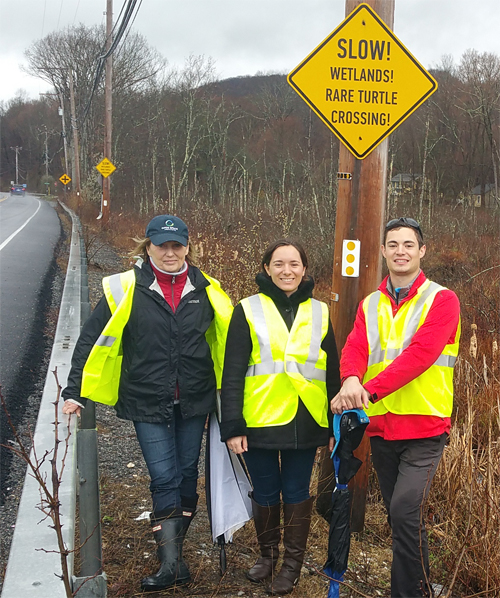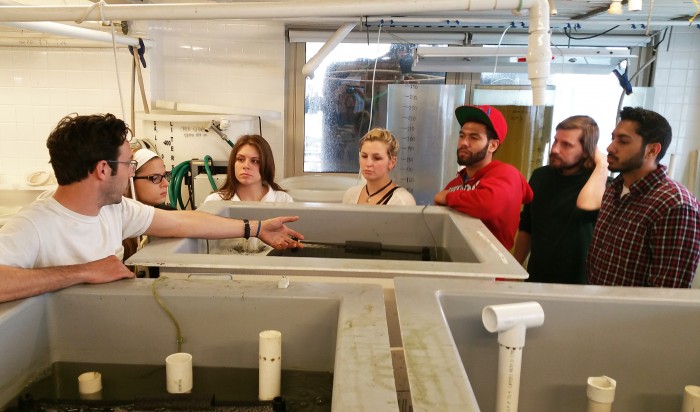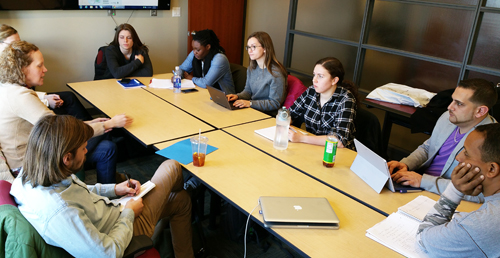![By Tehniyatshaikh (Own work) [CC BY-SA 3.0], via Wikimedia Commons](https://earthdesk.blogs.pace.edu/files/2015/02/water-sign-india.jpg)
Sign outside Armed Forces Medical College, Pune India, a common message worldwide. By Tehniyatshaikh (Own work) [CC BY-SA 3.0], via Wikimedia Commons
As last year, concerns about environmental and economic risks remain, in particular around failure of climate-change adaptation, water crises and unemployment and underemployment, reflecting concern about how little tangible action has been taken to address them. At the same time, cyber attacks remain among the most likely high-impact risks.
![By SuSanA Secretariat [CC BY 2.0], via Wikimedia Commons](https://earthdesk.blogs.pace.edu/files/2015/02/Boiling_water_with_biogas_sm.jpg)
Boiling water at a public latrine with a biogas stove in Ullalu near Bangalore. By SuSanA Secretariat [CC BY 2.0], via Wikimedia Commons
Those who follow global business and economic trends are unsurprised that WEF reports are increasingly dominated by environmental issues. While public attention and media are riveted by empty political debates about whether climate change is real, and whether God would allow humans to affect the planet negatively, the smart major corporations are figuring global environmental disruption into their long-term business plans.
In 2008, IBM issued its Global Innovation Outlook report that sounded an alarm about water:
[T]he future of the world’s most basic resource is changing in unprecedented ways. Immigration, population growth, and climate change are affecting the way we all think about our relationship with the world’s water supply. And by 2050, when the world’s population is expected to peak at about 9.4 billion people, it is conceivable that water could become one of the scarcest and most valuable commodities in the world.
When Jeffrey Imelt took over as General Electric’s CEO, one of his early actions was to ask his engineers and scientists to report back to him on whether climate change was real. Their finding was an unambiguous yes. On January 24, 2013, GE published the following on its Citizenship blog:
The year ahead will be dominated by growing tension between ever-stronger evidence of climate change and the inadequacy of the global policy response. Drought in the USA in 2012 highlighted the vulnerability of commodity prices to intensified weather risk, and 2013 is set to be another year of above-average global temperatures. But global greenhouse gas emissions are continuing to rise, putting the world on track for overshooting the 2ºC “safe” target and ending up in a 4ºC world.
There has been a slow, quiet revolution inside Fortune 500 companies. As they explore market opportunities for innovating adaptations that address the water and climate crises, they discover the inescapable links to public health, poverty and the developing world. From the GE Sustainability website:
Finding ways to help emerging economies meet rising demand for energy—set to grow 40% over the next two decades—is essential for bringing those economies out of poverty and improving human development. But at the same time, expanding fossil-fuel use is leading to increased greenhouse gas emissions that contribute to climate change, which threatens future development.
Of course, the argument can be made that companies make the connection between global economic welfare and environmental and social problems in order to eke every dollar out of any crisis. But these issues are inseparable, if we accept that innovation is a crucial element to solving global problems, the marketplace is an essential delivery system for innovation, and that business is not immune to the same disruptions.
Waterfootprint.org makes the point that our water future may depend on companies that make those connections:
Risks can turn into an opportunity for those companies that proactively respond to the challenge of global freshwater scarcity. Frontrunners that create product transparency before others do, that formulate specific and measurable targets with respect to water footprint reduction, with special attention to areas where problems of water scarcity and pollution are most critical, and that can demonstrate actual improvements, can turn this into a competitive advantage.
As important, water and climate issues have arrived on the doorstep of major corporations in ways that were once unthinkable. One example: on April 13, 2013, the Poughkeepsie Journal in New York topped its front page with this unusual headline: “IBM Demands Fewer Chemicals in Water.” The City of Poughkeepsie, NY supplied the treated water used in the company’s microchip fabrication plant in East Fishkill. The water originates from the Hudson River. In a letter made public, IBM told the city it required cleaner water for its chip manufacturing, even though the company performs its own additional filtration at the facility.
Those who live in the Hudson Valley are far more accustomed to the reverse — headlines that demand better environmental behavior from the region’s companies, including IBM. But the story is in keeping with a trend global in scope. Water conflicts, often with local communities, are determining forces in energy production and manufacturing, even in a company’s decision about what locale will be most accommodating to a new workforce.
Slowly, quietly, environmental affairs, water and climate in particular, have become big news inside the business world, and for every reason imaginable, from smart investments to overregulation to global security. For example, in the last two months alone, Forbes magazine has published six major stories about water — on policy, innovation, international affairs, poverty, Texas and China. (see links at conclusion of this post)
Though smart businesses appear to be on their own track, mostly out of public view, WEF observes that innovation is not keeping pace with profound global challenges. Also included in its latest findings are dire warnings about biodiversity, overfishing, deforestation and resource mismanagement. The conclusion of the Global Risks 2015 report warns that if short-term thinking delays adaptation it will be at great global peril:
Ten years of “doing risks” has also led to the recognition that a short-term vision prevents addressing long-term issues. Some slower-moving trends have continued inexorably: the last 10 years have brought conclusive proof that the earth’s climate is changing and that human activities are to blame – yet progress to mitigate greenhouse gas emissions remains frustratingly slow. This lesson is reflected this year in the introduction of different time horizons and the differentiation between risks and trends. Hopefully these innovations will help many public and private organizations around the world address this aspect of human nature in mitigating risks and building resilience.
In an upcoming post: the World Economic Forum’s deep dive into water issues.
«« »»
Links:
World Economic Forum Global Risks 2015
Forbes water articles,12/14 – 02/15:
- Thanks, EPA: Your New ‘Navigable Waters’ Rule Strengthens The Case Against Administrative Law;
- Solar And Water: Abengoa’s Big Bets; Stella Artois Partners With Water.org To End Women’s Journeys To Water;
- Watch Bill Gates Sip Water Made From Sewer Sludge ;
- Safe Water: A Currency For Peace;
- Water, Texas, and an Opportunity that should not be Wasted;
- China’s Grand Water Plan.









